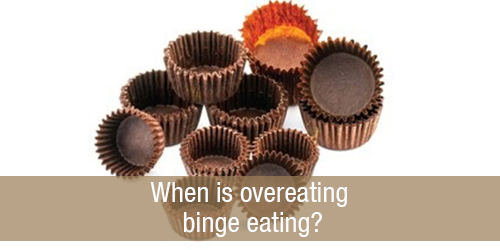While most people overeat at times, some may wonder, when is overeating binge eating disorder? Since it’s National Eating Disorders Awareness Week, let’s focus on the second most common eating disorder, Binge Eating Disorder (BED). Approximately 2.7% of women, 1.7% of men and 1.8% of adolescents suffer from BED.[1] This disorder is seen in all age groups, races, ethnic backgrounds, and socioeconomic income levels.
BED is characterized by recurrent episodes of binge eating—eating larger amounts of food in a discrete period of time than most people would in the same situation. Other associated behaviors include eating very rapidly, eating past the point of being full, eating when not hungry, and eating alone. This behavior is coupled with intense feelings of “loss of control” over eating, shame and guilt. BED is diagnosed when an individual engages in binge eating, on average, at least 1 day a week for 3 months.
What is a binge?
Binge eating episodes are associated with three or more of the following symptoms:
- Eating until you feel uncomfortably full
- Eating large amounts of food when not physically hungry
- Eating much more rapidly than usual
- Eating alone because you are embarrassed by how much you’re eating
- Feelings of loss of control
- Feeling disgusted, depressed, guilty, and/or ashamed after overeating
What is Binge Eating Disorder (BED)?
Binge Eating Disorder (BED) was added to the DSM-5 (Diagnostic and Statistical Manual of Mental Disorders) in May 2013.[1] Here’s a summary of the full diagnostic criteria for BED:
- BED may be diagnosed when binge eating occurs, on average, at least once a week for three months.
- The episodes are characterized by eating an amount of food that is definitely larger than most people would eat in a similar period of time under similar circumstances.
- There is a sense of lack of control over eating during the episode (e.g., a feeling that one cannot stop eating or control what or how much one is eating).
- There is marked distress about binge eating and there is no recurrent use of inappropriate compensatory behavior (for example, purging).
Take this screening test: Binge Eating Scale.
What does BED feel like?
Kari Anderson DBH, LPC, CEDS, an eating disorder specialist, co-author of Eat What You Love, Love What You Eat for Binge Eating and the Am I Hungry? Mindful Eating for Binge Eating Workbook and Awareness Journal and the co-creator of the Am I Hungry? Mindful Eating for Binge Eating Program, explains that a person with BED may eat “normally” with others, stop on the way home to buy “binge” foods, then binge and hide evidence of the episode. The aftermath of a binge episode involves extreme feelings of shame and disgust.
Kari adds, “Individuals with BED are typically competent and accomplished in other areas of their life, yet feel unable to stop this secret behavior. Bingeing is a way to escape or disconnect from thoughts and feelings that seem intolerable. There may be difficulty managing states of emotional and physical distress without using food. On the other hand, the thought of giving up the behavior evokes anxiety.”
While most people can relate to overeating or even bingeing from time to time, the lives of those with binge eating disorder are significantly disrupted by the binges and the aftermath.
Confusing binge eating and body size distracts clinicians and people with BED from seeking appropriate treatment for this common eating disorder. It is also important to note that not everyone with binge eating disorder (BED) is at a higher weight and most people who are at a higher weight do not have binge eating disorder. While people with BED commonly yo-yo diet, weight cycle, and even undergo weight loss surgery, restrictive dieting makes binge eating worse.
People with binge eating disorder may suffer in silence for years, feeling alone, ashamed, and depressed. But they are not alone; there are millions of people with BED.
How is BED treated?
 If you think you may have binge eating disorder, seek treatment from an experienced treatment specialist.
If you think you may have binge eating disorder, seek treatment from an experienced treatment specialist.
Mindfulness-based strategies aimed at self-regulating emotional and physical states have shown promise in the treatment of Binge Eating Disorder. Mindful eating strategies such as those described in Eat What You Love, Love What You Eat for Binge Eating are an important complement to therapy.
The comprehensive Am I Hungry?® Mindful Eating for Binge Eating (AIH ME-BE) Program is a clinically valid treatment that has been shown to stop binge eating. AIH ME-BE combines interactive, eye-opening workshops and small group therapy sessions led by a trained Am I Hungry? Mindful Eating for Binge Eating Program or Therapist.
With effective treatment, there is hope for recovery and the freedom to live the vibrant life you crave!
[1] Deloitte Access Economics. (2020). The Social and Economic Cost of Eating Disorders in the United States of America: A Report for the Strategic Training Initiative for the Prevention of Eating Disorders and the Academy for Eating Disorders. Available at: https://www.hsph.harvard.edu/striped/report-economic-costs-of-eating-disorders/
[2] American Psychiatric Association. (2013). DSM 5. American Psychiatric Association.
This article was updated from a previously published version.
Want to read more about binge eating?
What is the difference between emotional eating and binge eating?
Binge eating disorder and dieting: Often two sides of the same coin
Binge eating is chaotic eating

